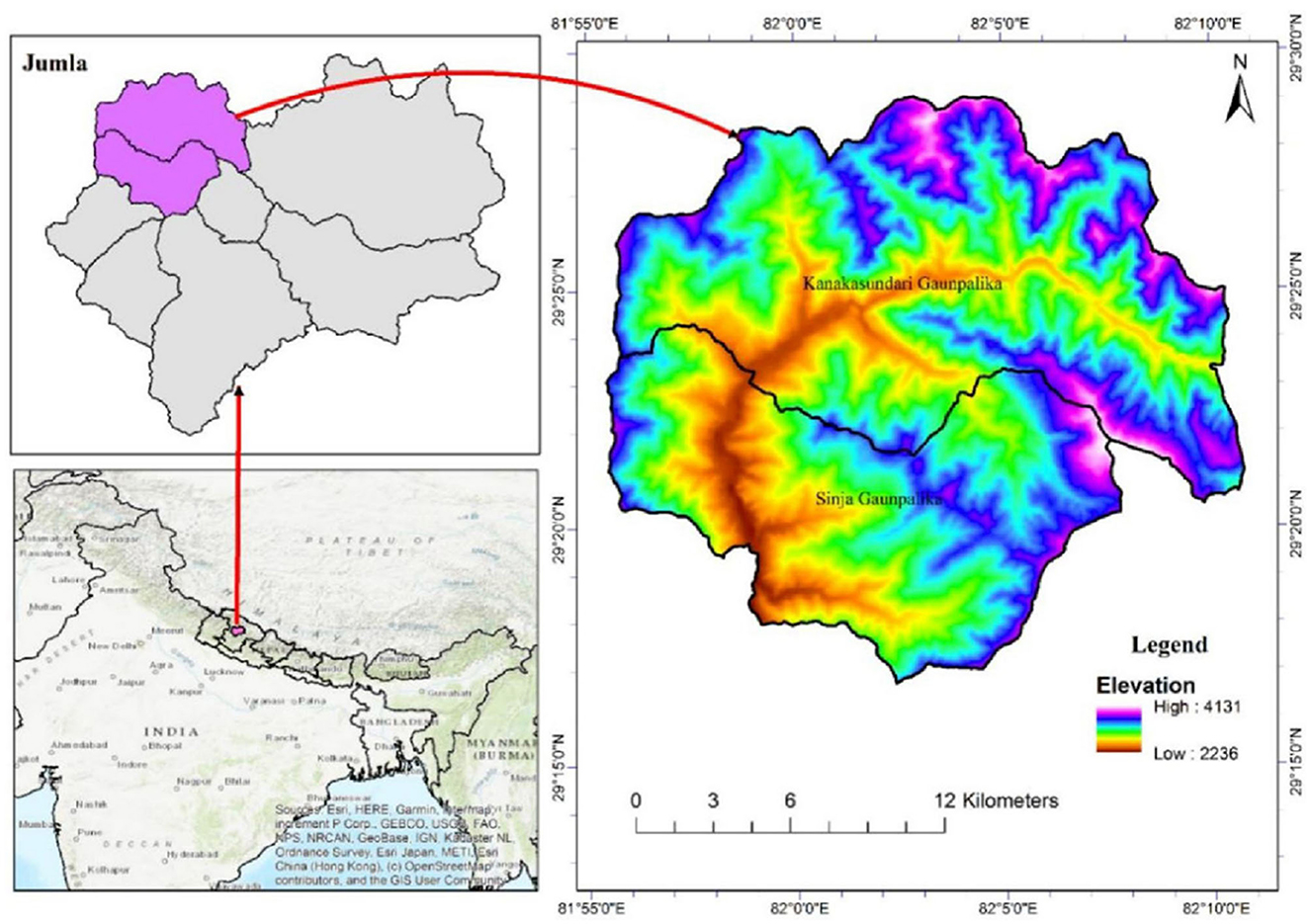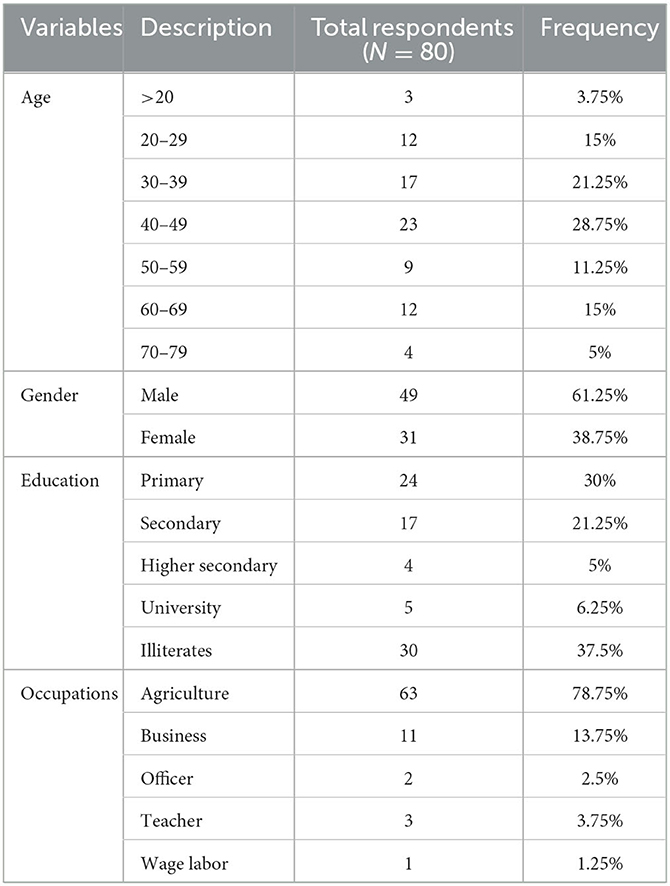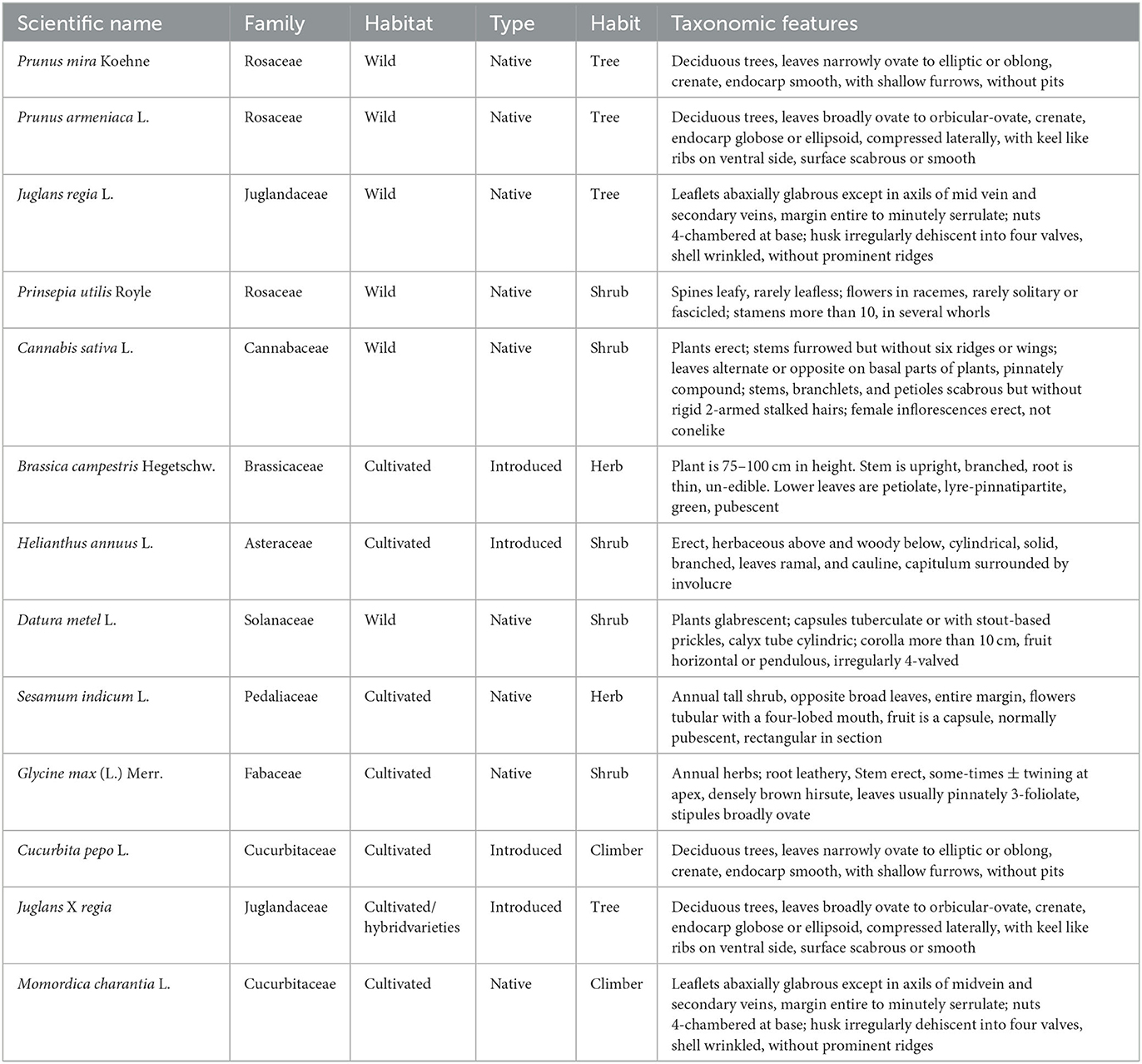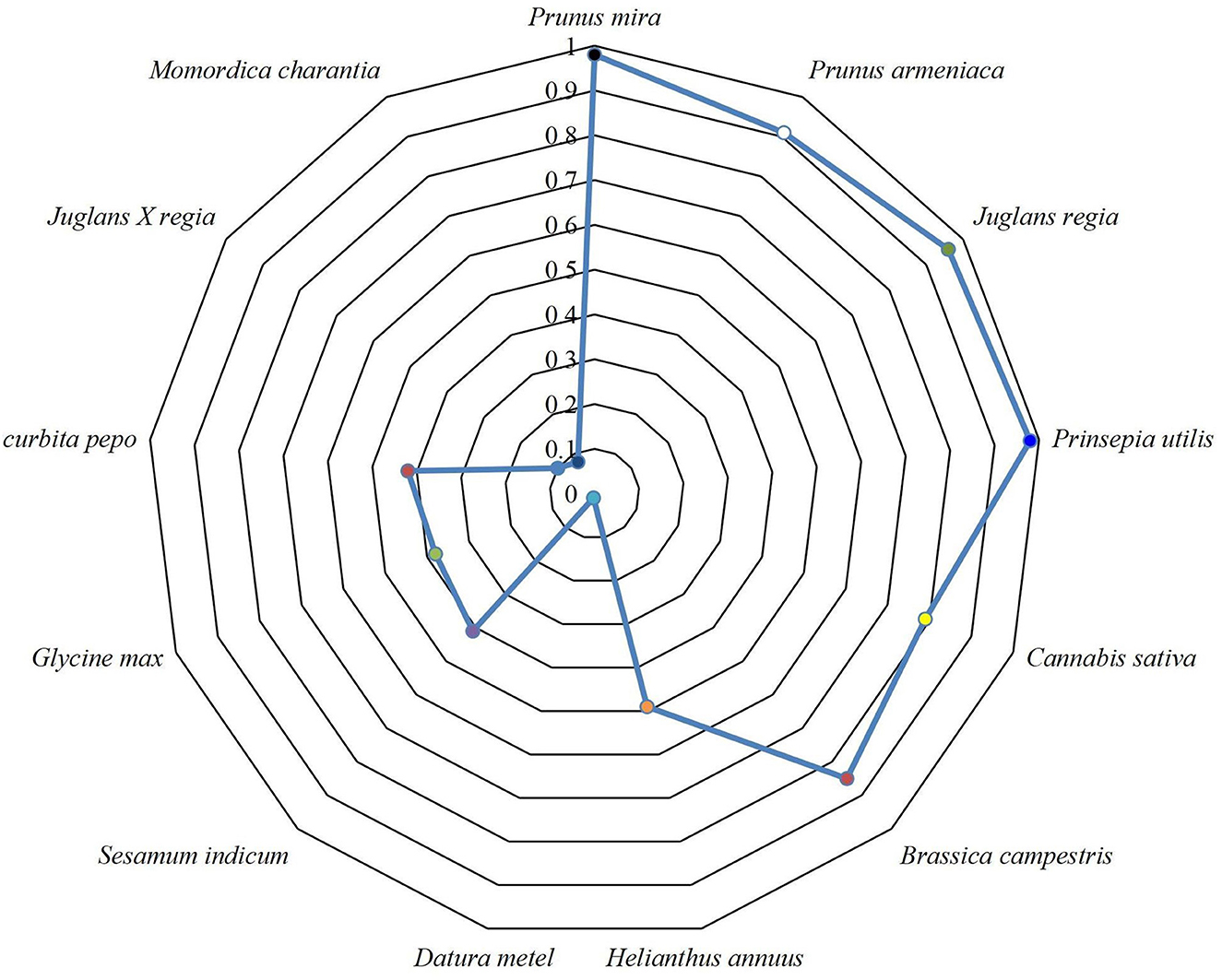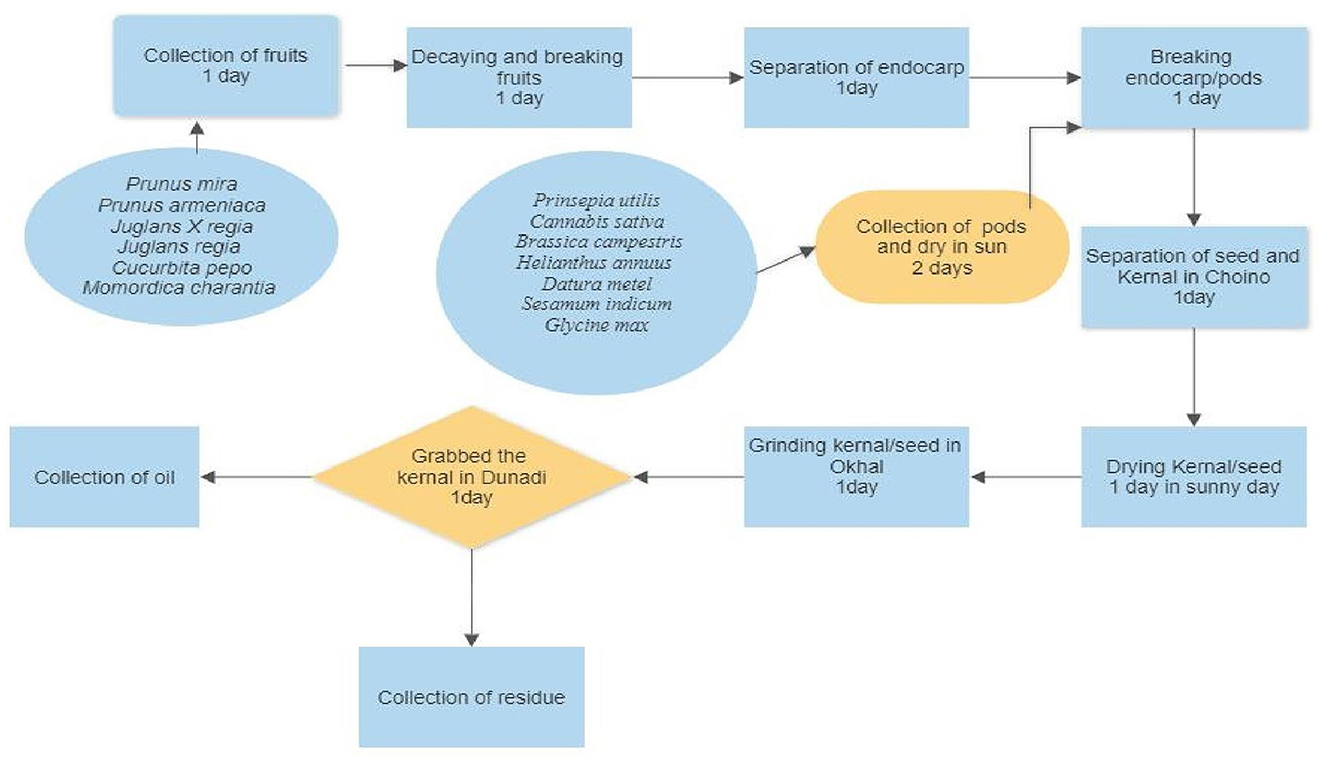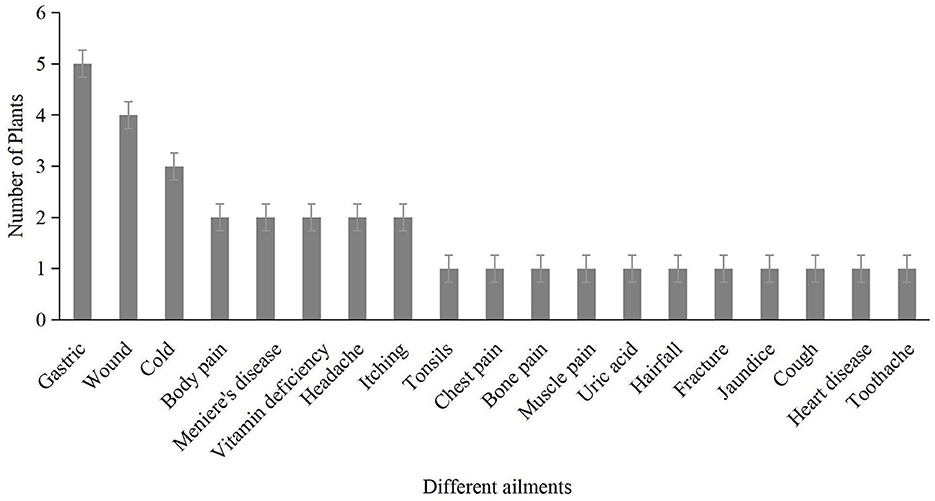- 1Guangdong Key Laboratory for Innovative Development and Utilization of Forest Plant Germplasm, College of Forestry and Landscape Architecture, South China Agricultural University, Guangzhou, China
- 2Environmental Science Program, Golden Gate International College, Kathmandu, Nepal
- 3Environment Protection and Study Center, Kathmandu, Nepal
- 4National Herbarium and Plant Laboratories, Lalitpur, Nepal
- 5Lushan Botanical Garden, Chinese Academy of Sciences, Lushan, Jiangxi, China
- 6Shunde Polytechnic, Foshan, China
- 7Central Department of Environmental Science, Tribhuvan University, Kathmandu, Nepal
- 8Ethnobotanical Society of Nepal, Kathmandu, Nepal
The indigenous people of Nepal have accumulated knowledge of plants and their uses spanning millennia of oral history, but the current sociodemographic trend threatens the transition of this knowledge. Recording the uses and knowledge of these plants is therefore imperative for revitalizing the traditions and culture and the sustainable use and availability of plant species. We interviewed a total of 80 Sinja Valley residents. We calculated the relative frequency of citations (RFC) of recorded edible oil plants. Using the Kruskal-Wallis test and the Wilcoxon test for gender, the difference in the use of edible oil plants mentioned by age group, education level, and occupation of the respondents was determined. These interviews yielded knowledge on 13 different edible oil-producing plant species (EOPPs) including nine indigenous species and six collected from the wild. EOPPs helped effectively treat 19 disorders with Prunus mira being considered a very good treatment for gastritis. Prinsepia utilis was the most common and frequently used (RFC = 0.99) edible oil-producing plant. Most respondents reported that oil-producing and oil-consuming cultures vary and are decreasing among Sinja Valley residents. The locals were subsistence farmers, and the edible oils for their household purposes were prepared using traditional knowledge. However, the tradition is scourged by commercially-available tawdry oil. In rural areas, the knowledge of edible oil-producing plants has been decimated due to outmigration and sociocultural transformation. Edible oil production from indigenous plants should continue for the culture and conservation of rural livelihood.
1. Introduction
Population growth and increased purchasing power have recently fueled the consumption of edible oil in the world (Wen et al., 2023), and the most popular edible oils are plant-based (Ju et al., 2023). Plant oil is a pollution-free renewable resource, and contains a variety of fatty acids and micronutrients that are beneficial to human health (Kumar et al., 2016). In Nepal, plant oil also plays an important role in people's daily life, however, the arduous task of plant oil production is primarily undertaken by a small number of rural individuals, and as a result, the country currently relies on imports from other countries for ~83% of its oil supply (Pokhrel, 2020). Few studies on edible oil-producing plants (EOPPs) in Nepal have been reported, in 1992, International Development Research Centre (INDRC) has recorded nine native EOPPs (Thomas et al., 1992). In 2018, Pokhrel and Gauchan (2018) recorded eight EOPPs, while Neupane and Gotame (2018) recorded 26 edible and non-edible oil seed plants. The demand for plant oil is flourishing in Nepal, however, the lack of information on the resource base, production volume, traditional uses, processing methods and conservation efforts of native edible oil-producing plants has led to an unfair market situation. In this regard, the research and conservation of edible EOPPs can help in the sustainable utilization of local resources, the creation of a fair market, and the reduction of dependence on imported edible oil, which contributes to supporting growing local economies, the national GDP, and food security (Olabisi et al., 2021). By cataloging the potential edible oil resources, resource-rich sites are better preserved, associated knowledge is conserved, and methods for the sustainable production and marketing of edible oils are developed (Jinadasa et al., 2022).
The Jumla district is one of the remote, rural, and rugged-terrain mountainous districts of western Nepal with severe food shortages and rapid urbanization (DOHS, 2022). Locals extract oil from edible plant oil seeds using local and traditional technologies (Kharel et al., 2021). Access to market oil has been made easy by the construction of roads and the expansion of transport access, reducing people's dependence on native oil-producing plants. Many households have abandoned the cultural practice of using native plants to produce edible oils due to reliance on commercial oils (Baral et al., 2021). The native oil seeds have both edible and pharmacological value, providing greater financial benefits to the locals and reducing their dependence on market oil if they can find a market for their sale. In this regard, we compiled an inventory of EOPPs, cataloged indigenous and traditional knowledge regarding their utilization and conservation, and devised sustainable use strategies. We hypothesized that better conservation and utilization of edible plants and oil would promote local biodiversity and livelihoods, given that better economic opportunities for people could reduce migration and land-use change. Given the historical and contemporary culture (UNESCO, 2008), we hypothesize that the Sinja Valley, Jumla District holds rich EOPPS knowledge, but this knowledge is imperiled. Due to socioeconomic transformation and climate change, knowledge regarding plant utilization, and conservation has diminished (Kunwar et al., 2016).
Some of the edible and medicinal plants related research in Jumla includes Gautam et al. (2022) on Marshi rice (Oryza sativa var. japonica), Timmermann and Smith-Hall (2019) on commercial medicinal plants, Gyawali and Paudel (2017) on plants used in ethno-veterinary practices, Atreya and Kafle (2016) on production market and value chain of Apple of Jumla, Joshi et al. (2011) on phytochemical extraction of some medicinal plants, Kunwar et al. (2006) on plants used in ethnomedicine, Manandhar (1986) on ethnobotany. However, the research on edible oil, its resources, and that from the remote district of Jumla is limited. Therefore, to fill this gap, we designed a study on the EOPPs of Sinja Jumla. Our study aimed to catalog the EOPPs of Jumla Valley, cross-cultural knowledge associated with them, traditional oil extraction knowledge, and medicinal values of and discuss EOPPs conservation. Our study helps to raise concern on EOPPs and support EOPPs conservation. Our study also shows an alternative option for reducing edible oil dependency on edible market oil. People will follow the modern methods for cultivating these plants and producing more oil to improve their economy and the country's economy (Taleuzzaman et al., 2022).
2. Materials and methods
2.1. Study area
The study area, Sinja Valley, is located in Jumla District, Karnali Province, Nepal, at 81° 58′ 43.1′′ E and 29° 13′ 45.56′′ N (Figure 1). In this valley, there are two rural municipalities: Sinja and Kanaka-Sundari. Sinja Valley is located between 2,100 and 4,000 m above sea level. The valley covers 378.59 km2 and has a temperate climate. The Sinja river flows from the valley's middle, as it is one of Nepal's historical sites that contains artifacts of the 12th−15th century Khas Kingdom (UNESCO, 2008). This region, home to the Khas people, is the birthplace of Nepal's official language, Nepali. Even though the area was the center of medieval Nepali culture, it is now relatively isolated, with limited transportation facilities and motorized roads. During the rainy season (26 February−23 October), the average rainfall in Jumla is 12.7 mm per month, and the temperature ranges between 10 and 21.11°C (Dhakal et al., 2020). This area's clayey, moist soil is renowned for its high calcium, magnesium, phosphorus, and copper content (Khadka et al., 2019). In the past, most people used to go to Dullu Dailekh during the winter to avoid cold. This culture has changed due to increased transportation facilities, market facilities, abandoning agricultural practices, and changing environmental conditions; fewer people go to Dullu and take medicinal and farm products, including EOPPs products, to sell them. Instead of Dullu now, more people go to Kohalpur, Nepalgunj, Surkhet, and Kathmandu during the winter.
2.2. Data collection
Between August and September 2021, semi-structured interviews were conducted to collect data and information regarding the distribution, utilization, and conservation of EOPPs. Gender, age groups, education level, and occupation were taken as the variables for data collection and analysis. Prior to the interview, consent was obtained orally from each respondent and from the municipality and district authorities. The International Society of Ethnobiology (2006) ethical guidelines were followed when collecting and analyzing the data and information.
We followed settlement based random sampling methods using mature individual for selecting the 80 residents of Sinja Valley Jumla for the interview in which 49 (61.25%) were male and 31 (61.25%) were female (38.75%).The age of the respondents ranged from 19 to 79 years old. Most respondents were 40–49 (n = 23, 28.75%), followed by those aged 30–39 (n = 17, 21.25%). Most respondents (n = 30, 37.5%) were illiterate. Agriculture accounted for the majority of household income in the area, 63 (78.75%), followed by non-timber forest products (NTFP) businesses (Table 1). The locals used to sell the collected forest products for their livelihood.
The interview gathered information about the EOPPs' local names and uses. The information sought in the semi-structured interview concerned (1) the distribution and abundance of EOPPs, (2) the population status of EOPPs, and (3) the traditional knowledge of EOPP identification and conservation. To identify and determine the scientific names of the plants, we consulted the flora of Nepal and other online databases (https://www.gbif.org; http://www.theplantlist.org). The voucher specimen was collected, photographed, and compared with specimens housed at the National Herbarium and Plant Laboratories (KATH) in Godawari, Lalitpur, Nepal, for identification, validation, and herbarium purpose.
2.3. Data analysis
Using the function RFC = FC/N, each species' relative frequency (RFC) was calculated to determine their importance in edible oil production (Tardío and Pardo-de-Santayana, 2008). FC = frequency of citations (the number of respondents who mention a particular species); N = total number of respondents.
We used the Kruskal-Wallis test to compare the number of edible oil-producing plants by age group, education level, occupation, and gender (using Wilcoxon) (R Core Team, 2020).
3. Results and discussions
3.1. Edible oil-producing plants
From interactions with locals, it is known that a decade ago, most people in this district obtained their daily oil needs from native oil plants, but this has changed over time. In this study, only 13 plant species, representing 11 genera and nine families, were identified as EOPPs (Table 1) and used for local livelihood and primary healthcare. Seven species (53.85%) were cultivated in homestead areas, while six species (46.15%) were grown in the wild. Table 2 shows that most were shrubs (38.46%) and trees (30.76%). These species provide oil seeds, fodder, and fuel wood that benefit local livelihood and household economy. Nine species were native to the regions, while four were introduced. Brassica campestris, Helianthus annuus and Sesamum indicum were reported as EOPPs by the International Development Research Centre (INDRC) (Thomas et al., 1992).
3.2. Important edible oil plants based on their usefulness
The species most frequently cited for edible oil in Jumla was Prinsepia utilis (79 citations, 0.99 frequency), followed by Prunus mira (78 citations, 0.98 frequency) (Figure 2). The highest relative frequency of citations for Prinsepia utilis and Prunus mira means these plants are popular for edible oil production. The two most useful plants were collected from the wild. In addition to local uses for livelihood and folklore, respondents described the economic benefits of the species, such as selling oil was mentioned by 13 (16.25%) of the respondents, similar to other studies (Basiron and Weng, 2004; Jamwal et al., 2021). However, that do not cover the significant income of the respondent. Momordica charantia and Cucumis pepo were commonly domesticated for vegetables in this region, and some households used their seeds to produce oil. P.mira, P. aremenica, J. regia, J. X regia are used in making furniture and fuel wood.
In Sinja Valley, the species Helianthus annus, reported as an edible and high-oil-seed-producing plant (Maroufi et al., 2011), was introduced. Among these plants, Prinsepia utilis, followed by Prunus mira, Prunus aremenica, Juglans regia, and Cannabis sativa, were cited most as edible oil plant species. Some respondents believe that Prinsepia utilis oil is better than ghee due to its medicinal functions and consumption as a vitamin. According to Maikhuri et al. (1994), this species is an essential edible oil-bearing plant in the Indian higher Himalaya. Other EOPPs, including Brassica campestris, Sesamum indicum, and Momordica charantia, were abundant in the Sinja Valley's higher elevations.
3.3. Cross-cultural knowledge
Each respondent reported between three and 12 EOPPs (Figure 3). Knowledge of EOPPs with respondents' education level (Kruskal-Wallis, χ2 = 3.11, df = 4, p = 0.538), gender (Wilcox test, W = 800, p = 0.683), and occupation (Kruskal-Wallis, χ2 = 5.3379, df = 4, p = 0.254) did not differ significantly. However, there were age-related differences in knowledge (Kruskal-Wallis, χ2 = 15.93, df = 6, p = 0.014). Men between the ages of 40 and 49 with university-level education and an agropastoral occupation possessed rich knowledge of oil-producing plants. Figure 3 (No. of plants used vs. age of respondents) demonstrates that despite being insignificant, the continuous age data of respondents, regressed with the number of EOPPs used, revealed a decreasing pattern of knowledge over time (p = 0.52, t = −0.63, R2 = 7%). A weak association between age and plant use knowledge may be attributed to (non-random) selective collection and use and the elders' unwillingness or inability to share their traditional knowledge (Kunwar et al., 2018). In addition, there was a knowledge gap in identifying, using, and adding value to species products (Kalauni and Joshi, 2018), which may have been due to the rapid development of remote areas and the decline in reliance on traditional knowledge. The decline in herbal medicine use is mostly due to an increase in allopathic medication use and its widespread availability, even in small towns. In the future, this circumstance could result in losing traditional and essential plant information that could be useful in healthcare management (Harsha et al., 2002).
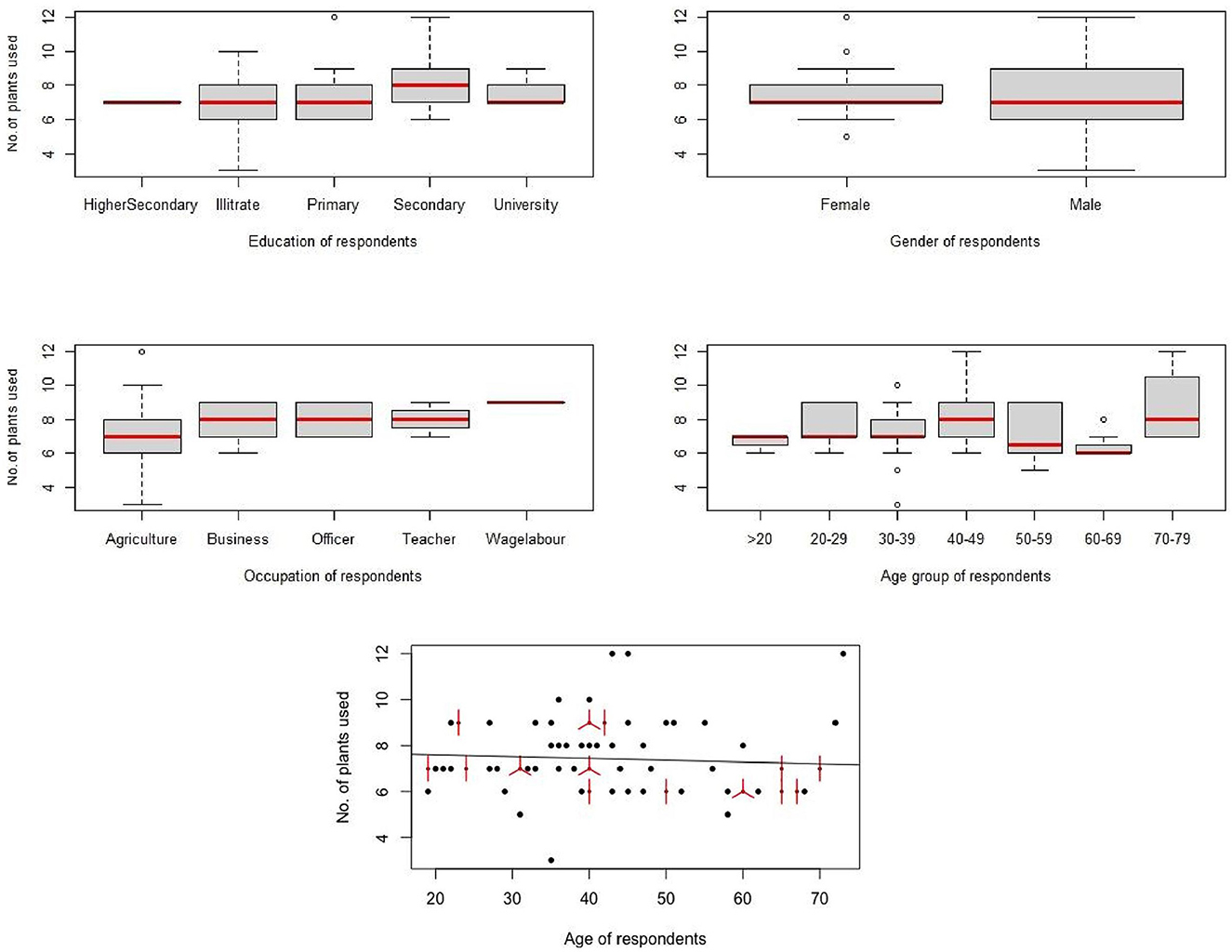
Figure 3. Relationship between edible oil-producing plants mentioned with education, gender, occupation, age group, and age.
3.4. Traditional knowledge of oil extraction
In the Sinja Jumla Valley, the traditional oil extraction technology still persists. Collecting and breaking the seed cover takes 1–2 days, followed by 1–2 days of work of separation of the endocarp and seed. This practice is used for P. mira, P. armeniaca, J. regia, J. X regia, C. pepo, and M. charantia. Meanwhile, the seeds are easily separated for B. campestris, C. sativa, D. metel, G. max, H. annus, P. utilis, and S. indicum. Using a Choino (a rectangular bamboo material measuring 0.52 × 0.4 m with an inner length of 0.33 × 0.33 m, a depth of 0.1 m, and several narrow passages at the base) to obtain the seed or kernel from the fruit and then sun-drying the extract for 1 day is a traditional practice. Grinding the seeds with a Musal (a 1.3-m-long wooden instrument with an iron material at the tip) or an Okhal (a stony or wooden material with a 0.3-m-diameter, 0.5-m-deep pit) is indigenous, and some tools have been modified to handle the extract better. The ground material is grabbed and ground in a Dunadi (rectangular wooden curve material about external size 0.7 × 0.29 m, inner size 0.46 × 0.2 m, depth 0.1 m) with a narrow passage in one or two corners to collect oil from it in suitable vessels in a pot, a bucket, or a curved plate (Figures 4, 5).
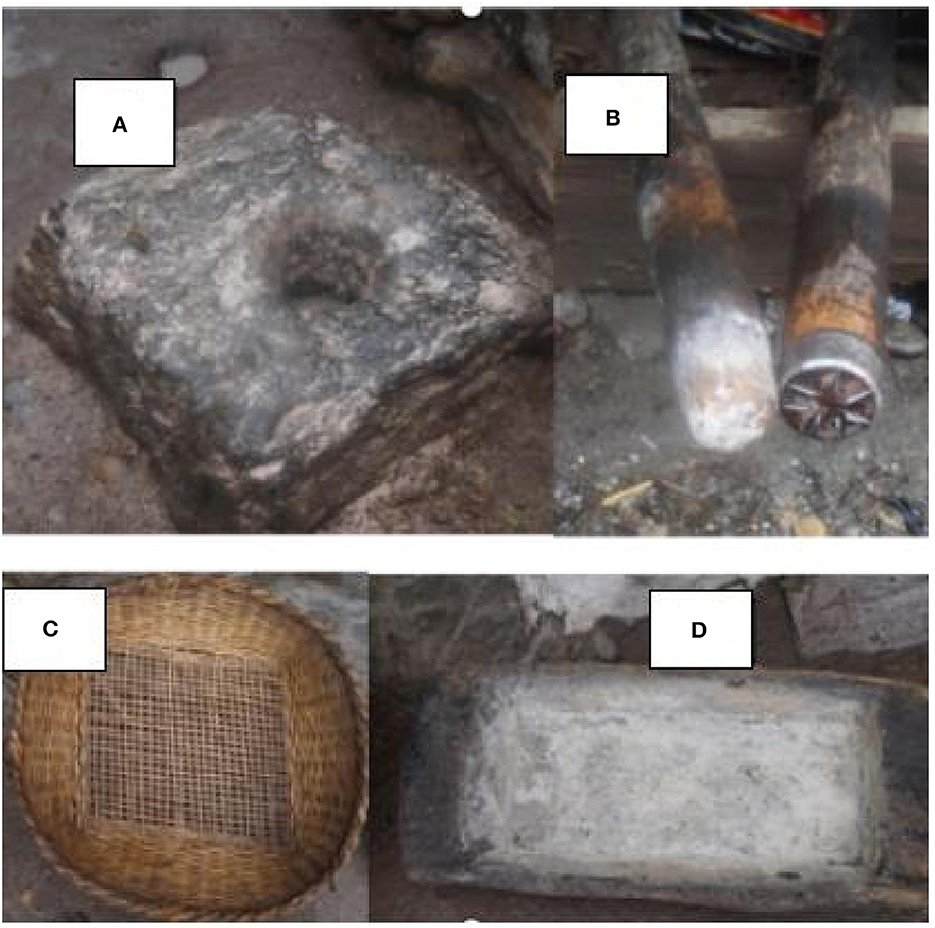
Figure 5. Major instruments used in edible oil extraction process (A) Okhal, (B) Musal, (C) Choino, and (D) Dunadi.
The entire collection, drying, and oil extraction process for 20 kg of seed or kernel may take 1 week and yield an average of 8 liters of oil (maximum for Juglans and minimum for Prunus mira), but this varies with the seed materials, quality, and species. The amount of fatty acid present in the seeds determines the quality of the edible oil, indicating that these species are beneficial in producing edible oil. For instance, Prinsepia utilis contains 29.57% polyunsaturated and 25.53% monounsaturated fatty acids (Kewlani et al., 2022); Prunus mira contains 31.76% polyunsaturated and 57.67% monounsaturated fatty acids (Zhang et al., 2022); Prunus armeniaca contains 62.5–71.2% monounsaturated fatty acids (Gupta et al., 2012); Juglans regia contains 85% unsaturated fatty acids (Tsamouris et al., 2002); Cannabis sativa contains more than 75% polyunsaturated and unsaturated fatty acids (Teleszko et al., 2022). Among the 13 plants recorded in this study, oil content was reported highest in Juglans regia, followed by B. campestris, S. indicum, P. armeniaca, P. mira, and the least in D. metel by other studies (Table 2). Only a few operations were observed in the village despite cultural differences. Moreover, the people's reliance on local edible oil-producing plants has been diminished due to increased access to the market through road access, making market oil easily available in rural areas (Shively and Thapa, 2017).
3.5. Medicinal use of EOPPs
Besides edible oil, the seed, stem, root, flower, and branch of the 13 species were also employed in medicinal concoctions, with the seed (61.54%), root (23.07%), stem (7.69%), and leaf (7.69%) being the most frequent folk remedies (Table 3). As the root and oil of P. mira are organoleptic, it is popular in the valley to treat body aches and gastritis. Its roots contain a high amount of bioactive chemicals (Moore, 1994), contributing to its widespread use in folk medicine. Eight of thirteen species were reported as ethnomedicinal and used to treat 19 human diseases. Five plants were used to treat gastritis (Prunus mira, Datura metel, Cannabis sativa, Prinsepia utilis, Juglans regia), followed by four plants for wounds (P. mira, Prunus armeniaca, J. regia, and P. utilis), and three for common cold (P. mira, P. utilis, and Sesamum indicum) (Figure 6). Two plants (P. utilis and P. mira) could treat itching, vitamin deficiency, and tonsils. The majority of remedies were for gastrointestinal problems such as gastritis. P. armeniaca was used to treat heart disease and fractures, while Cannabis sativa was used to treat bone pain. Plants were also essential as appetite stimulants and tonics. Despite being medicinal, D. metel, S. indicum, G. max, C. pepo, and M. charantia, were under-reported for ethnomedicinal uses in Sinja, Jumla (Table 2), although Jumla is rich in medicinal plants (Gyawali and Paudel, 2017). Therefore, people may have neglected the medicinal use of common plants D. metel, S. indicum, G. max, C. pepo, and M. charantia. Besides medicinal uses, EOPPs are also collected for household economy through local livelihood (Kunwar and Bussmann, 2008). Out of these 13 species except H. annuus, S. indicum other 11 species are used for multiple purpose in Sinja Valley. P.mira, P. aremenica, J. regia are used in food, medicine, making furniture and fuel wood. J. X regia is used in food and fuel wood. B. campestris and G. max are used in medicine, vegetables and feeding animals. P. utilis is used as fruit, used in color and to mark the boundary of the land. M. charantia and C. pepo are used in vegetables and feeding animals. C. sativa and D. metel are used in ethnomedicine and ethnovetnary. This shows that P.mira, P. aremenica, J. regia are having more threat than other EOPPs as plant used in wood and fuelwood is a threat of species conservation in Himalaya (Parajulee et al., 2022). These three species P.mira, P. aremenica, J. regia also have multiple use and have greater preferences than other species, such species need further investigation and conservation measures (Tahir et al., 2023).

Table 3. Edible oil-producing plants with medicinal use, parts use, habitat, methods of use, frequency of citations and relative frequency of citations.
The local conservation status and availability were assessed following participatory observation. People reported that ten out of 13 species (P. mira, P. utilis, C. sativa, B. campestris, H. annuus, D. metel, S. indicum, G. max, C. pepo, J. X regia), are increasing, whereas species like P. aremenica, J. regia, and M. charantia are decreasing. The probable causes of the decline are urbanization, socio-acculturation, land use change, climate change, and migration that cause over harvesting and habitat destruction of certain species (Khakurel et al., 2021). Species were conserved to sustain the long-term use of plant species due to the existing harvesting practices (Kunwar et al., 2016). However, the frequent collection and use of plant roots and stems for ethnomedicine in traditional practices (e.g., P. mira and P. utilis) may pose sustainability concerns (Essandoh et al., 2023).
3.6. Implications for conservation
People have historically relied on plants for food and medications to treat common ailments. However, without proper and timely documentation and transmission, the younger generation is unconcerned about ethnobotanical knowledge. It is important to note that the conservation of traditional knowledge of medicinal plant usage is important for both environmental management and the conservation of culture and heritage (Cameron, 2008). This knowledge promotes local communities' health and socioeconomic development and should be recorded and digitized throughout Nepal (Ghimire, 2021). The government should incorporate this traditional knowledge of EOPPs into the agroforestry system, and make conservation choices based on the plant species people use (Atreya et al., 2021). Before traditional knowledge is lost, the government should also encourage its proper transmission (Shrestha and Dhillion, 2006). Both in-situ conservation and extensive cultivation on farmlands may aid the production of tradable quantity of oil that supports sustainability and fair market price.
4. Conclusions
The current study demonstrates that rural communities possess a wealth of knowledge regarding resource sites and traditional ethnobotanical uses of oil-producing plant species that have yet to be thoroughly investigated and recorded in the scientific literature. The rural inhabitants of Sinja Valley depend on plants for food, fodder, oil, vegetables, and even ingredients for primary health care and household economy. We recorded nine indigenous and four introduced species of EOPPs, of which six grew in the wild, and seven were cultivated. Sustainable collection and commercial uses of both wild and cultivated species help retain the cultural heritage and replace non-organic markets. The EOPPs were folkloric for treating 19 diseases, with Prunus mira oil being considered a good constituent for gastritis. The promotion of wild-base and organic edible oil is needed for cultural heritage and health hygiene.
Data availability statement
The original contributions presented in the study are included in the article/supplementary material, further inquiries can be directed to the corresponding authors.
Author contributions
DK: Conceptualization, Data curation, Formal analysis, Investigation, Methodology, Software, Writing—original draft, Writing—review and editing. HP: Validation, Writing—review and editing, Investigation, Visualization. BL: Writing—review and editing, Supervision, Validation, Visualization. MD: Resources, Writing—review and editing, Validation, Visualization. NB: Investigation, Writing—review and editing, Resources. SB: Resources, Writing—review and editing, Investigation. PA: Conceptualization, Writing—review and editing, Supervision. RK: Conceptualization, Data curation, Formal analysis, Supervision, Validation, Visualization, Writing—review and editing. DC: Conceptualization, Funding acquisition, Supervision, Writing—review and editing, Project administration, Resources. SS: Conceptualization, Funding acquisition, Project administration, Resources, Supervision, Validation, Writing—review and editing.
Funding
This research was funded by the Science and Technology Projects in Guangzhou, grant number 202102021016 and Foshan science and Technology Plan Project, grant number 2220001005758.
Acknowledgments
We would like to thank all the respondents who participated in this survey. We thank Satyam Kumar Chaudhari for helping in data management, editing and visualization. Dr. Amy Eisenberg and Dr. Christopher Leboa for their support in smoothing English in this manuscript.
Conflict of interest
The authors declare that the research was conducted in the absence of any commercial or financial relationships that could be construed as a potential conflict of interest.
Publisher's note
All claims expressed in this article are solely those of the authors and do not necessarily represent those of their affiliated organizations, or those of the publisher, the editors and the reviewers. Any product that may be evaluated in this article, or claim that may be made by its manufacturer, is not guaranteed or endorsed by the publisher.
References
Ahmad, M., Sultana, S., Fazl-i-Hadi, S., Ben Hadda, T., Rashid, S., Zafar, M., et al. (2014). An ethnobotanical study of medicinal plants in high mountainous region of Chail valley (District Swat-Pakistan). J. Ethnobiol. Ethnomed. 10, 1–18. doi: 10.1186/1746-4269-10-36
Ahuja, K. L., Batta, S. K., Raheja, R. K., Labana, K. S., and Gupta, M. L. (1989). Oil content and fatty acid composition of promising Indian Brassica campestris L. (Toria) genotypes. Plant Foods Human Nutr. 39, 155–160. doi: 10.1007/BF01091895
Akkaya, M. R., Cil, A., ÇIL, A. N., Yücel, H., and Kola, O. (2018). The influence of sowing dates on the oil content and fatty acid composition of standard, mid-oleic and high-oleic types of sunflower (Helianthus annuus L.). Food Sci. Technol. 39, 448–453. doi: 10.1590/fst.20118
Al-Snafi, A. E. (2017). Medical importance of Datura fastuosa (syn: Datura metel) and Datura stramonium-A review. IOSR J. Pharm. 7, 43–58. doi: 10.9790/3013-0702014358
Anwar, F., Latif, S., and Ashraf, M. (2006). Analytical characterization of hemp (Cannabis sativa) seed oil from different agro-ecological zones of Pakistan. J. Am. Oil Chem. Soc. 83, 323–329. doi: 10.1007/s11746-006-1207-x
Atreya, K., Subedi, B. P., Ghimire, P. L., Khanal, S. C., Charmakar, S., and Adhikari, R. (2021). Agroforestry for mountain development: prospects, challenges and ways forward in Nepal. Arch. Agric. Environ. Sci. 6, 87–99. doi: 10.26832/24566632.2021.0601012
Atreya, P. N., and Kafle, A. (2016). Production practice, market and value chain study of organic apple of Jumla. J. Agric. Environ. 17, 11–23. doi: 10.3126/aej.v17i0.19855
Awasthi, C. P., Sood, S., Acharya, M. K., and Sharma, N. (2006). Biochemical composition and fatty acid profile of some promising sesame (Sesamum indicum L.) genotypes. Indian J. Agric. Biochem. 19, 67–70.
Baral, S., Gauli, K., Kunwar, R. M., Turi, M. A., Bussmann, R. W., and Paniagua-Zambrana, N. Y. (2021). “Prinsepia utilis Royle ROSACEAE,” in Ethnobotany of the Himalayas, eds R. Kunwar, H. Sher, and R. Bussmann (Berlin: Springer), 197.
Basiron, Y., and Weng, C. K. (2004). The oil palm and its sustainability. J. Oil Palm Res. 16, 1–10.
Cameron, M. (2008). Modern desires, knowledge control, and physician resistance: regulating Ayurvedic medicine in Nepal. Asian Med. 4, 86–112. doi: 10.1163/157342108X381232
Chang, M. K., Conkerton, E. J., Chapital, D. C., Wan, P. J., Vadhwa, O. P., and Spiers, J. M. (1996). Chinese melon (Momordica charantia L.) seed: composition and potential use. J. Am. Oil Chem. Soc. 73, 263–265. doi: 10.1007/BF02523907
Dhakal, R., Yadav, B. K., Koirala, N., Kumal, B. B., and Moussa, H. (2020). Feasibility study of distributed wind energy generation in Jumla Nepal. Int. J. Renew. Energy Res. 10, 1501–1513. doi: 10.31224/osf.io/gfkd6
DOHS (2022). Annual Report. Department of Health Services. Available online at: https://dohs.gov.np/wp-content/uploads/2022/07/DoHS-Annual-Report-FY-2077-78-date-5-July-2022-2022_FINAL.pdf (accessed August 8, 2023).
Essandoh, P. K., Dali, G. L.A., and Bryant, I. M. (2023). Medicinal plant use and integration of traditional healers into health care system: a case study at Ankasa Forest Reserve and catchment communities in Ghana. Ethnobot. Res. Appl. 26, 1–24. doi: 10.32859/era.26.15.1-24
Farias, T. C., D'Almeida, S., de Souza, T. S., do Nascimento, T. P., de Sousa Bezerra, F., da Silva, R. N.P., et al. (2022). “Application of metabolomic tools to survey the phenolic composition of food, medicinal plants, and agro-industrial residues,” in Nutriomics (Boca Raton, FL: CRC Press), 235–286. doi: 10.1201/9781003142195
Gautam, R., Kandel, B. P., Chalaune, S., and Koirala, B. (2022). Importance of world high altitude Jumli Marshi rice with cultivation practices. Heliyon 8, e08885. doi: 10.1016/j.heliyon.2022.e08885
Gavarkar, P., Thorat, S., Adnaik, R., Mohite, S., and Magdum, C. (2016). Characterization and formulation of skin cream from seed oil extracted from Cucumis Melo. Pharm. Lett. 8, 90–93.
Ghimire, P. (2021). Digitalization of indigenous knowledge in Nepal—review article. Acta Inform. Malays 5, 42–47. doi: 10.26480/aim.02.2021.42.47
Gupta, A., Sharma, P. C., Tilakratne, B. M. K. S., and Verma, A. K. (2012). Studies on Physico-Chemical Characteristics and Fatty Acid Composition of Wild Apricot (Prunus armeniaca Linn.) Kernel Oil. Indian J. Nat. Prod. Resour. 3, 366–370.
Gyawali, R. R., and Paudel, H. R. (2017). Plant bio-resources used in ethno-veterinary practices in Jumla District. Nepalese Vet. J. 34, 128–134. doi: 10.3126/nvj.v34i0.22915
Harsha, V. H., Hebbar, S. S., Hegde, G. R., and Shripathi, V. (2002). Ethnomedical knowledge of plants used by Kunabi Tribe of Karnataka in India. Fitoterapia 73, 281–287. doi: 10.1016/S0367-326X(02)00078-3
Huang, S., Ma, Y., Zhang, C., Cai, S., and Pang, M. (2017). Bioaccessibility and antioxidant activity of phenolics in native and fermented Prinsepia utilis Royle seed during a simulated gastrointestinal digestion in vitro. J. Funct. Foods 37, 354–362. doi: 10.1016/j.jff.2017.08.004
International Society of Ethnobiology (2006). International Society of Ethnobiology Code of Ethics (With 2008 Additions). Available online at: http://ethnobiology.net/~code-of-ethics/ (accessed August 8, 2023).
Jamwal, R., Kumari, S., Sharma, S., Kelly, S., Cannavan, A., and Singh, D. K. (2021). Recent trends in the use of FTIR spectroscopy integrated with chemometrics for the detection of edible oil adulteration. Vib. Spectrosc. 113, 103222. doi: 10.1016/j.vibspec.2021.103222
Jia, S., Shen, M., Zhang, F., and Xie, J. (2017). Recent advances in Momordica charantia: functional components and biological activities. Int. J. Mol. Sci. 18, 2555. doi: 10.3390/ijms18122555
Jinadasa, B. K. K. K., Van Bockstaele, F., Cvejic, J. H., and Simal-Gandara, J. (2022). “Current trends and next generation of future edible oils,” in Future Foods, ed R. Bhat (Academic Press), 203–231. doi: 10.1016/B978-0-323-91001-9.00005-0
Jing, W. G., Wang, Z. M., Zhao, Y., Fu, J., Zhao, X. L., and Liu, A. (2014). Chemical constituents from seeds of Brassica campestris. China J. Chin. Mater. Med. 39, 2521–2525.
Joshi, B., Sah, G. P., Basnet, B. B., Bhatt, M. R., Sharma, D., Subedi, K., et al. (2011). Phytochemical extraction and antimicrobial properties of different medicinal plants: Ocimum sanctum (Tulsi), Eugenia caryophyllata (Clove), Achyranthes bidentata (Datiwan) and Azadirachta indica (Neem). J. Microbiol. Antimicrob. 3, 1–7.
Ju, Z., Fan, J., Meng, Z., Lu, R., Gao, H., and Zhou, W. (2023). A high-throughput semi-automated dispersive liquid–liquid microextraction based on deep eutectic solvent for the determination of neonicotinoid pesticides in edible oils. Microchem. J. 185, 108193. doi: 10.1016/j.microc.2022.108193
Kalauni, D., and Joshi, A. (2018). Status of medicinal and aromatic plant (maps) and socio-economic influence in Nepalese livelihood-a review research. Acta Sci. Agric. 2, 123–130.
Kewlani, P., Tewari, D. C., Singh, L., Negi, V. S., Bhatt, I. D., and Pande, V. (2022). Saturated and polyunsaturated fatty acids rich populations of Prinsepia utilis Royle in western Himalaya. J. Oleo Sci. 71, 481–491. doi: 10.5650/jos.ess21262
Khadka, D., Lamichhane, S., Amgain, R., Joshi, S., Shree, P., Kamal, S. A.H., et al. (2019). Soil fertility assessment and mapping spatial distribution of Agricultural Research Station, Bijayanagar, Jumla, Nepal. Eur. J. Soil Sci. 8, 237–248. doi: 10.18393/ejss.566551
Khakurel, D., Uprety, Y., Łuczaj, Ł., and Rajbhandary, S. (2021). Foods from the wild: local knowledge, use pattern and distribution in Western Nepal. PLoS ONE 16, e0258905. doi: 10.1371/journal.pone.0258905
Kharel, S., Marahatta, D., and Limbu, B. (2021). Assessing household's food security in Patarasi rural municipality of Jumla district of Karnali Province, Nepal. Nepal. J. Dev. Rural Stud. 18, 48–56. doi: 10.3126/njdrs.v18i01.41949
Kitic, D., Miladinovic, B., Randjelovic, M., Szopa, A., Sharifi-Rad, J., Calina, D., et al. (2022). Anticancer potential and other pharmacological properties of Prunus armeniaca L.: an updated overview. Plants 11, 1885. doi: 10.3390/plants11141885
Kumar, A., Sharma, A., and Upadhyaya, C. K. (2016). Vegetable oil: nutritional and industrial perspective. Curr. Genom. 17, 230–240. doi: 10.2174/1389202917666160202220107
Kunwar, R. M., Baral, K., Paudel, P., Acharya, R. P., Thapa-Magar, K. B., Cameron, M., et al. (2016). Land-use and socioeconomic change, medicinal plant selection and biodiversity resilience in far Western Nepal. PLoS ONE 11, e0167812. doi: 10.1371/journal.pone.0167812
Kunwar, R. M., and Bussmann, R. W. (2008). Ethnobotany in the Nepal Himalaya. J. Ethnobiol. Ethnomed. 4, 1–8. doi: 10.1186/1746-4269-4-24
Kunwar, R. M., Fadiman, M., Cameron, M., Bussmann, R. W., Thapa-Magar, K. B., and Rimal, B. (2018). Cross-cultural comparison of plant use knowledge in Baitadi and Darchula districts, Nepal Himalaya. J. Ethnobiol. Ethnomed. 14, 1–17. doi: 10.1186/s13002-018-0242-7
Kunwar, R. M., Nepal, B. K., Kshhetri, H. B., Rai, S. K., and Bussmann, R. W. (2006). Ethnomedicine in Himalaya: a case study from Dolpa, Humla, Jumla and Mustang districts of Nepal. J. Ethnobiol. Ethnomed. 2, 1–6. doi: 10.1186/1746-4269-2-27
Li, C., Miao, H., Wei, L., Zhang, T., Han, X., and Zhang, H. (2014). Association mapping of seed oil and protein content in Sesamum indicum L. using SSR markers. PLoS ONE 9, e105757. doi: 10.1371/journal.pone.0105757
Liu, X. S., Gao, B., Li, X. L., Li, W. N., Qiao, Z. A., and Han, L. (2020). Chemical composition and antimicrobial and antioxidant activities of essential oil of sunflower (Helianthus annuus L.) receptacle. Molecules 25, 5244. doi: 10.3390/molecules25225244
Lu, Z., Tian, L., Hao, G., Yuan, C., Zhang, S., and Guo, X. (2016). Oil content and composition analysis in kernels of five kinds of wild nuts. Jiangsu Agric. Sci. 44, 317–320.
Maikhuri, R. K., Singh, A., and Semwal, R. L. (1994). Prinsepia utilis Royle: a wild, edible oil shrub of the higher Himalayas. Bull. Ressour. Phytogenet. 98, 5–8.
Manandhar, N. P. (1986). Ethnobotany of jumla district, Nepal. Int. J. Crude Drug Res. 24, 81–89. doi: 10.3109/13880208609083311
Manzoor, M., Anwar, F., Ashraf, M., and Alkharfy, K. M. (2012). Physico-chemical characteristics of seed oils extracted from different apricot (Prunus armeniaca L.) varieties from Pakistan. Grasas Aceites 63, 193–201. doi: 10.3989/gya.095011
Maroufi, K., Farahani, H. A., and Aghdam, A. M. (2011). Effect of nanopriming on germination in sunflower (Helianthus Annus L.). Adv. Environ. Biol. 5, 3747–3750.
Matthaus, B., Özcan, M. M., and Al Juhaimi, F. (2016). Fatty acid composition and tocopherol content of the kernel oil from apricot varieties (Hasanbey, Hacihaliloglu, Kabaasi and Soganci) collected at different harvest times. Eur. Food Res. Technol. 242, 221–226. doi: 10.1007/s00217-015-2533-8
Mondal, M. R. I., and Wahhab, M. A. (2001). Production Technology of Crops. Joydebpur: Oil seed Research Center, Bangladesh Agril. Res. Inst. 1–10.
Neupane, R. K., and Gotame, T. P. (2018). “A classification of agronomic crop species based on use values,” in Working Groups of Agricultural Plant Genetic Resources (APGRs) in Nepal. Proceedings of a National Workshop, Kathmandu, Nepal, 70–87.
Olabisi, M., Obekpa, H. O., and Liverpool-Tasie, L. S.O. (2021). Is growing your own food necessary for dietary diversity? Evidence from Nigeria. Food Policy 104, 102144. doi: 10.1016/j.foodpol.2021.102144
Parajulee, D., Subedi, G., and Giri, B. (2022). Ethnobotanical study of wild edible plants in Pyuthan district. Matrix Sci. Pharma 6, 62–67. doi: 10.4103/mtsp.mtsp_7_21
Poggetti, L., Ferfuia, C., Chiabà, C., Testolin, R., and Baldini, M. (2018). Kernel oil content and oil composition in walnut (Juglans regia L.) accessions from north-eastern Italy. J. Sci. Food Agric. 98, 955–962. doi: 10.1002/jsfa.8542
Pokhrel, A., and Gauchan, D. (2018). “Potential Fuel Crops Species and Grouping Systems for their Conservation and Sustainable Use in Nepal,” in Working Groups of Agricultural Plant Genetic Resources (APGRs) in Nepal. Proceedings of a National Workshop, Kathmandu, Nepal
Pokhrel, S. (2020). Food availability and consumption in relation to developing strategies for sustained production and supply in Nepal. J. Agric. For. Univ. 13–28. doi: 10.3126/jafu.v4i1.47024
R Core Team (2020). R: A Language and Environment for Statistical Computing. R Foundation for Statistical Computing.
Rai, I., Bachheti, R. K., Joshi, A., and Pandey, D. P. (2013). Physicochemical properties and elemental analysis of some non cultivated seed oils collected from Garhwal region, Uttarakhand (India). Int. J. Chem. Tech. Res. 5, 232–236.
Ramak, P., and Mahboubi, M. (2019). The beneficial effects of pumpkin (Cucurbita pepo L.) seed oil for health condition of men. Food Rev. Int. 35, 166–176. doi: 10.1080/87559129.2018.1482496
Shively, G., and Thapa, G. (2017). Markets, transportation infrastructure, and food prices in Nepal. Am. J. Agric. Econ. 99, 660–682. doi: 10.1093/ajae/aaw086
Shrestha, P. M., and Dhillion, S. S. (2006). Diversity and traditional knowledge concerning wild food species in a locally managed forest in Nepal. Agroforest. Syst. 66, 55–63. doi: 10.1007/s10457-005-6642-4
Tahir, M., Asnake, H., Beyene, T., Van Damme, P., and Mohammed, A. (2023). Ethnobotanical study of medicinal plants in Asagirt District, Northeastern Ethiopia. Trop. Med. Health 51, 1–13. doi: 10.1186/s41182-023-00493-0
Taleuzzaman, M., Ahmad, A., and Gilani, S. J. (2022). “Socio-economic importance of some promising edible medicinal plants from Rajasthan, India,” in Edible Plants in Health and Diseases: Volume 1: Cultural, Practical and Economic Value, eds M. H. Masoodi, M. U. Rehman (Singapore: Springer Nature Singapore), 31–53. doi: 10.1007/978-981-16-4880-9_2
Tardío, J., and Pardo-de-Santayana, M. (2008). Cultural importance indices: a comparative analysis based on the useful wild plants of Southern Cantabria (Northern Spain). Econ. Bot. 62, 24–39. doi: 10.1007/s12231-007-9004-5
Teleszko, M., Zajac, A., and Rusak, T. (2022). Hemp seeds of the Polish “Bialobrzeskie” and “Henola” varieties (Cannabis sativa L. var. sativa) as prospective plant sources for food production. Molecules 27, 1448. doi: 10.3390/molecules27041448
Thomas, N., Singh, B., and Riley, K. (1992). Evaluation of Oilseeds (Nepal). Wallingford: International Development Research Centre.
Timmermann, L., and Smith-Hall, C. (2019). Commercial medicinal plant collection is transforming high-altitude livelihoods in the Himalayas. Mt. Res. Dev. 39, R13–R21. doi: 10.1659/MRD-JOURNAL-D-18-00103.1
Tsamouris, G., Hatziantoniou, S., and Demetzos, C. (2002). Lipid analysis of Greek walnut oil (Juglans regia L.). Zeitschrift Naturforschung C 57, 51–56. doi: 10.1515/znc-2002-1-209
UNESCO (2008): Sinja Valley Nepal. Criteria: (ii)(iii) Department of Archaeology. Available online at: https://whc.unesco.org/en/tentativelists/5263/ (accessed August 8, 2023)..
Wani, S. M., Masoodi, F. A., Wani, T. A., Ahmad, M., Gani, A., and Ganai, S. A. (2015). Physical characteristics, mineral analysis and antioxidant properties of some apricot varieties grown in North India. Cogent. Food Agric. 1, 1118961. doi: 10.1080/23311932.2015.1118961
Wen, C., Shen, M., Liu, G., Liu, X., Liang, L., Li, Y., et al. (2023). Edible vegetable oils from oil crops: preparation, refining, authenticity identification and application. Process Biochem. 124, 168–179. doi: 10.1016/j.procbio.2022.11.017
Zhang, J., Chen, W., Sun, W., Zhou, Y., Li, X., Zhang, et al. (2022). Prunus mira Koehne in Sichuan, China: recorded history as a medicine and food, modern applications, distribution, and ethnobotanical investigations. Front. Pharmacol. 13, 826712. doi: 10.3389/fphar.2022.826712
Keywords: edible oil, ethnobotany, medicinal plants, oil plants, traditional knowledge
Citation: Khadka D, Paudel HR, Luo B, Ding M, Basnet N, Bhatta S, Aryal PC, Kunwar RM, Cui D and Shi S (2023) Edible oil-producing plants in the Sinja Valley, Jumla, Nepal. Front. Sustain. Food Syst. 7:1276988. doi: 10.3389/fsufs.2023.1276988
Received: 13 August 2023; Accepted: 08 September 2023;
Published: 28 September 2023.
Edited by:
Bikash Baral, University of Helsinki, FinlandReviewed by:
Maroof Ali, Chinese Academy of Sciences (CAS), ChinaShreehari Bhattarai, Agriculture and Forestry University, Nepal
Copyright © 2023 Khadka, Paudel, Luo, Ding, Basnet, Bhatta, Aryal, Kunwar, Cui and Shi. This is an open-access article distributed under the terms of the Creative Commons Attribution License (CC BY). The use, distribution or reproduction in other forums is permitted, provided the original author(s) and the copyright owner(s) are credited and that the original publication in this journal is cited, in accordance with accepted academic practice. No use, distribution or reproduction is permitted which does not comply with these terms.
*Correspondence: Shi Shi, c2hpc0BzY2F1LmVkdS5jbg==; Dafang Cui, Y3VpZGZAc2NhdS5lZHUuY24=
 Dipak Khadka
Dipak Khadka Hem Raj Paudel
Hem Raj Paudel Binsheng Luo5
Binsheng Luo5 Prakash Chandra Aryal
Prakash Chandra Aryal Ripu M. Kunwar
Ripu M. Kunwar